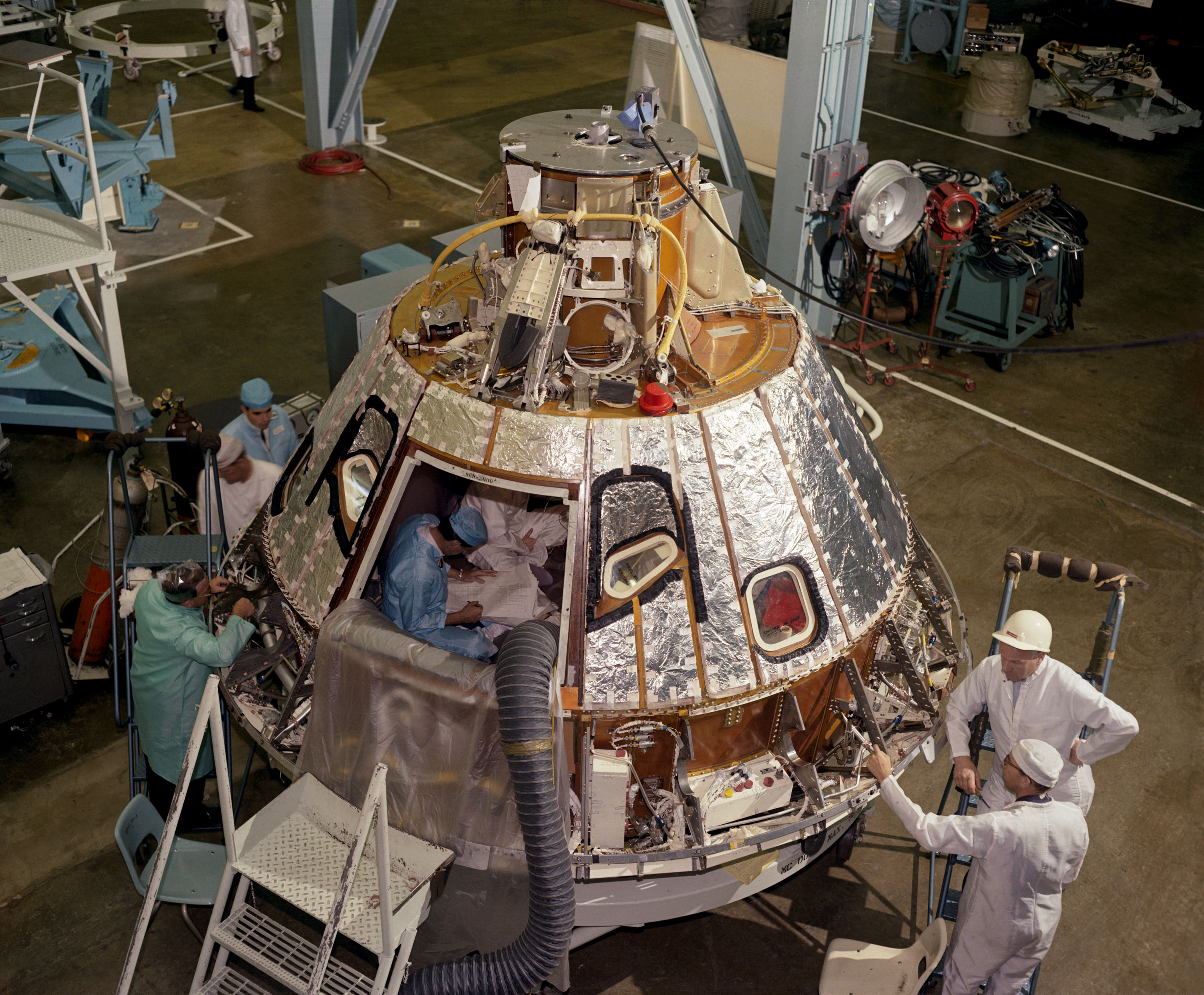
It is rare to find a space mission which was born, thrived, and ended within a matter of weeks; a mission whose crew never left Earth, lived to tell the tale, and went on to fly another mission which sowed the seeds for the grandest scientific endeavor ever undertaken in human history. Yet that is exactly what happened with the unflown voyage of Apollo 2, whose crew was announced to the world, 50 years ago, this fall. Theirs might have been the second test-flight of the Block I Command and Service Module (CSM) and they might have spent up to two weeks in orbit, putting the ship which would someday carry men to the Moon through its paces, close to the Earth. It is a pity that the very nature of Apollo 2—together with a mission commander who did not want to fly it—ultimately proved its downfall.
As outlined in yesterday’s AmericaSpace history article, the Apollo program was America’s drive to land a man on the Moon before 1970, thereby fulfilling a pledge to the nation and the world by the late President John F. Kennedy. The spacecraft would be several orders of magnitude more complex than its Mercury and Gemini predecessors and was actually divided into two types: “Block I,” devoted exclusively to Earth-orbital missions, and “Block II,” which were equipped with the rendezvous and navigational hardware, docking equipment and the Lunar Module (LM) to venture beyond low-Earth orbit to reach the Moon. When the Apollo 1 prime crew of Commander Virgil “Gus” Grissom, Senior Pilot Ed White, and Pilot Roger Chaffee were named in March 1966, they were tasked with flying a Block I CSM for up to 14 days in February 1967. Their original backups were astronauts Jim McDivitt, Dave Scott, and Rusty Schweickart, who would then rotate into the prime crew of a later mission, probably involving rendezvous and the LM.
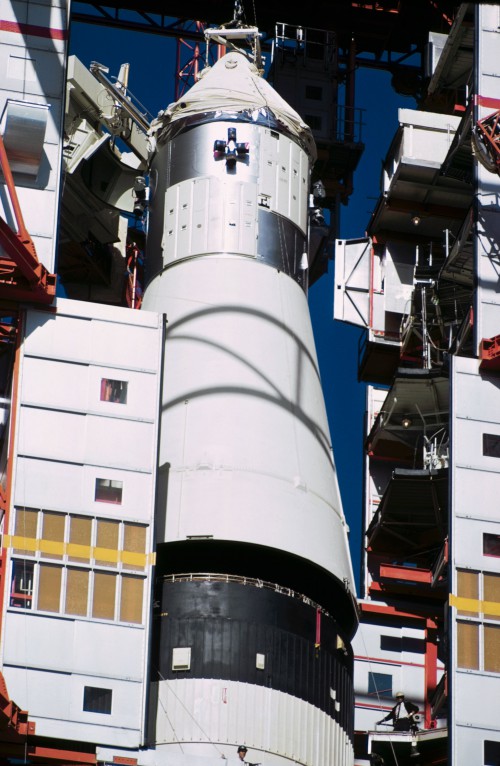
Yet the complexity of Apollo led Deke Slayton, then-head of Flight Crew Operations, to put another crew into training for Apollo 2. Commander Wally Schirra—a veteran flyer from Projects Mercury and Gemini—would lead Senior Pilot Donn Eisele and Pilot Walt Cunningham on an “open-ended” mission in the first half of 1967. The crew was assigned in January 1966, but was not formally announced by NASA until the following 29 September. “I was excited and at the same time a little disappointed,” wrote Cunningham in his memoir, The All-American Boys. “We would be flying a mission which was a virtual repeat of the first Apollo flight and in a virtually identical Block I spacecraft … There was some office gossip that the Block I missions were just to keep the program moving while we waited for Block II to come down the pike. The gossip would prove to be well-founded.”
Schirra’s crew quickly earned the moniker “Wally, Walt and Whatshisname,” because no one seemed able to pronounce Eisele’s surname. (Even President Lyndon B. Johnson mispronounced it “Isell.”) “It wasn’t a crew I planned to use on lunar landing missions,” wrote Slayton in his autobiography, Deke. “Wally was making noises about retiring and I figured to move Donn and Walt over to Apollo Applications [after Apollo 2]. The mission wouldn’t break any new ground. As the second and last flight of a Block I command module, it wouldn’t even be equipped for rendezvous and docking with a lunar module.”
And therein, for Schirra at least, lay the crux of the problem. For Apollo 2 would virtually duplicate all of Apollo 1’s tasks. “Gus Grissom and his crew would prove that the spacecraft could fly and support man in space,” wrote Cunningham. “If Gus accomplished what was expected, our flight would be as useless as windshield wipers on a submarine.” Its primary focus was to repeat and develop the engineering tests from its predecessor, with a secondary thrust upon scientific research. Flying for up to 14 days, the Apollo 2 astronauts would perform four test-firings of their spacecraft’s Service Propulsion System (SPS) engine, a simulated re-rendezvous and transposition and docking with the S-IVB third stage of the Saturn IB booster—providing real-world experience ahead of the first LM flights—and support 15 medical and scientific experiments.
Right from the start, Schirra argued that it made “no sense” to essentially repeat what Apollo 1 had already done. And from their perspective, Eisele and Cunningham agreed with him. “Flying virtually identical missions in outmoded Command Modules, when then Block II vehicle was so much better for the program, was not my idea of the planning and efficiency that NASA had been noted for,” Cunningham wrote. “Consequently, Donn and I never really felt comfortable about the permanence of our mission in the flight schedule.” In his memoir, Cunningham noted that Deke Slayton—grounded from his Mercury mission by a persistent heart murmur—had hoped to be medically fit to secure command of Apollo 2 for himself. In the meantime, Schirra considered himself to be “the caretaker commander,” and eventually wound up with a mission he did not want when Slayton remained grounded.
By the late summer of 1966, the backup crew for Apollo 2 had crystallized. Commanded by Frank Borman, it also included Tom Stafford and Mike Collins, all of whom had recently wrapped up prime-crew duties within Project Gemini. Together with the six-strong prime and backup crew members for Apollo 1, these dozen men worked to get the Block I spacecraft ready for its maiden mission. Like engineering and operational consultants, they worked with Apollo’s prime contractor, North American Rockwell, as the program struggled against ballooning costs and schedules. Moreover, serious safety issues with the Block I vehicle—which would be made horrifyingly manifest in the Apollo 1 fire—had raised the ire of both Grissom and Schirra.
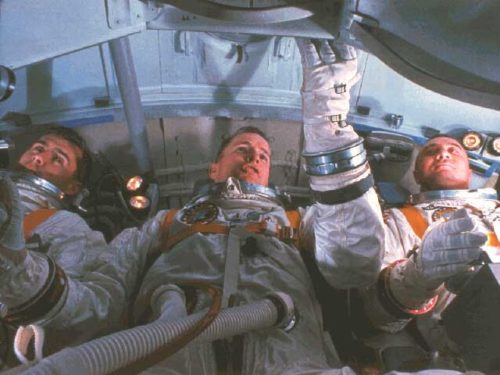
According to historian David J. Shayler in his Springer-Praxis survey of lost and forgotten Apollo missions, had Schirra’s flight taken place, it might have secured a new record for the longest piloted space voyage to date. At the time, the longest mission was Gemini VII in December 1965, when astronauts Frank Borman and Jim Lovell spent 13 days, 18 hours, and 35 minutes away from terra firma. Apollo 1 was expected to eclipsed this by about 15 minutes and it remained Schirra’s intention to push the lead still further, by flying Apollo 2 for 13 days, 19 hours, and 33 minutes.
But the hands of fate turned decisively on Apollo 2 on 25 October 1966, when a propellant tank inside one of the Service Modules ruptured during a ground test in Downey, Calif. Subsequent analysis determined that a structural failure, caused by interaction of methyl alcohol—used to simulate the presence of fuel—and the stressed titanium skin of the tank itself. Although this particular flight hardware was not assigned to Apollo 2, it made sense to keep downstream flights on schedule, replace it with Schirra’s Service Module, and cancel his mission entirely.
The unwelcome news was broken to Schirra on 15 November 1966, the day on which astronauts Jim Lovell and Edwin “Buzz” Aldrin returned to Earth, closing out the final mission of Project Gemini. NASA public affairs officer Paul Haney handed Schirra the text of an impending press release, announcing Apollo 2’s cancelation. “His face flamed,” Cunningham wrote of Schirra’s reaction. “Even though Wally hadn’t exactly been thrilled over making the flight, he wasn’t prepared to have it taken away from him, and certainly not in this manner.”
In the days and weeks which followed, McDivitt, Scott, and Schweickart were moved from their original place on the Apollo 1 backup crew and reassigned as prime crewmen for the “new” Apollo 2, which was now expected to stage the maiden voyage of the Block II spacecraft. As for “Wally, Walt and Whatshisname,” their experience with the Block I hardware led them to be assigned as the “new” backup crew for Apollo 1, standing in reserve for Grissom, White, and Chaffee. It seemed unlikely that they would subsequently be rotated into a new prime crew and in Cunningham’s words, the hapless crew were in limbo. Less than 10 weeks later, on 27 January 1967, they had finished a series of ground tests at Cape Kennedy and returned to Ellington Field, near Houston, Texas.
The prime crew, meanwhile, remained at the Cape to wrap up an extended “plugs-out” test of the Apollo 1 spacecraft, atop its unfueled Saturn IB booster on Pad 34. For a while, Schirra, Eisele, and Cunningham opted to remain in Florida, expecting the test to be over quickly. However, as a myriad of problems plagued the test through the afternoon, they decided to return to Houston, expecting Grissom’s crew to follow them the next day. No one could have imagined that fire would engulf Apollo 1 that night, killing Grissom, White, and Chaffee and stalling Project Apollo for almost two years. By terrible irony, Schirra, Eisele, and Cunningham were subsequently assigned as the prime crew for Apollo 7, the first manned mission by the new spacecraft in low-Earth orbit. None of them flew again after Apollo 7, and none of them ventured beyond low-Earth orbit, but their mission laid a critical cornerstone in humanity’s journey to the Moon.
This is part of a series of history articles, which will appear each weekend, barring any major news stories. Next week’s article will focus on the anniversary of John Glenn’s flight aboard Space Shuttle Discovery in October 1998.
Be sure to “Like” AmericaSpace on Facebook and follow us on Twitter: @AmericaSpace
Missions » Apollo » Missions » Apollo » Apollo 1 »



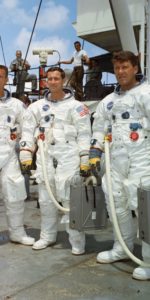
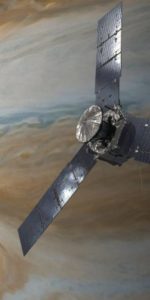
Quite an interesting and fascinationg article on Apollo 2. It is a piece of space history usually overlooked. Thank youm Ben, for bringing it to your readers.
It’s interesting that this article should have gone up the weekend I was in Grand Rapids, Michigan, Roger Chaffee’s hometown, for the big comic con there. While I was up there, I took the opportunity to renew the pledge I made to him last year that we would not leave him stuck dead forever, that we would develop the necessary technology to piece him back together so he could finally get his spaceflight, because I know that he deserves to fly in space.